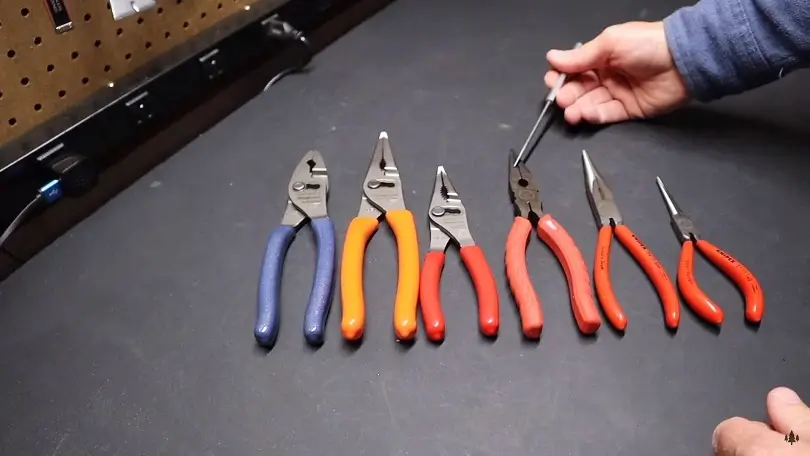Welcome to the world of needle nose pliers! Parents and teachers, gather around. I will tell you about a useful tool. It is called needle nose pliers. It helps in many ways.
What are Needle Nose Pliers?
Needle nose pliers also known as long nose pliers or pointy pliers, are a type of hand tool commonly used in various industries and hobbies. They are characterized by their long, slender jaws that taper to a fine point at the tips. The jaws are typically flat on the inside and may have serrated or cross-hatched surfaces to provide a better grip on materials.
The design of needle nose pliers allows for precise control and access to tight spaces. The elongated jaws enable users to reach into narrow areas, loops, or confined spaces where regular pliers may not fit. The pointed tips make it easier to grasp and manipulate small objects or components with accuracy.
These pliers are usually made of durable materials such as steel, which ensures strength and longevity. They often feature insulated handles for electrical work or ergonomic grips for improved comfort during extended use.
Needle nose pliers come in various sizes to accommodate different tasks and user preferences. Some models may have additional features near the base of the jaws, such as wire cutters or wire stripping areas, adding to their versatility.
These pliers find application in a wide range of fields, including electrical work, electronics repair, jewelry making, crafts, automotive repairs, and general DIY projects. They are particularly useful for tasks that demand precision, fine control, and access to confined spaces.
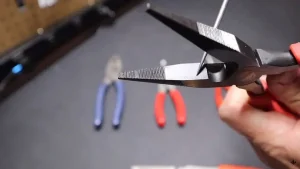
Design and Features of Needle Nose Pliers
The design and features of the needle nose plier are specifically tailored to enable precise control, access to tight spaces, and versatile functionality. Here are the key design elements and features of needle nose pliers:
Jaws: The needle nose plier has long, slender jaws that taper to a fine point at the tips. The jaws are typically flat on the inside, allowing for a secure grip on objects. The pointed tips enable users to reach into narrow spaces and grasp small objects with accuracy.
Material and Construction: The Needle nose plier is commonly made of durable materials such as hardened steel or high-strength alloys. This ensures strength, durability, and resistance to wear and tear. The pliers are often constructed with precision machining for smooth operation and reliable performance.
Ergonomic Handles: Many needle nose pliers feature ergonomic handles designed for comfort and reduced hand fatigue during extended use. The handles may have a contoured shape that fits comfortably in the hand, and they may be coated with non-slip materials to enhance grip and control.
Serrated Jaws: Some nose pliers have serrated or cross-hatched patterns on the inside of the jaws. These serrations provide an improved grip on materials, especially when working with wires, small parts, or slippery surfaces. The serrated jaws help prevent slipping and ensure a secure hold.
Wire Cutter: Many needle nose pliers have an integrated wire cutter near the base of the jaws. This feature allows for convenient cutting of wires, eliminating the need for a separate cutting tool. The wire cutter is typically designed to handle various wire gauges and provides clean, precise cuts.
Spring-Loaded Action: Some pliers incorporate a spring-loaded mechanism that automatically opens the jaws when pressure is released. This feature reduces hand fatigue and makes repetitive tasks more efficient by eliminating the need to manually open the jaws after each squeeze.
Insulated Handles: The needle nose pliers intended for electrical work often have insulated handles. The insulation provides electrical safety by protecting users from accidental contact with live wires or electrical components. Insulated handles are typically color-coded for easy identification.
Size and Variation: Needle nose pliers are available in various sizes to suit different tasks and user preferences. Smaller sizes are suitable for delicate work, while larger sizes offer increased leverage for heavier-duty applications. Additionally, there are variations of needle nose pliers, such as bent nose or angled needle nose pliers, which provide unique angles and access for specific tasks.
Overall, the design and features of needle nose pliers make them versatile and essential tools for tasks that require precision, access to tight spaces, and secure gripping of small objects.
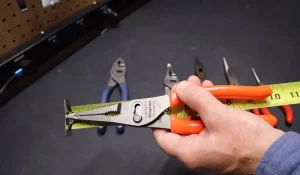
Common Uses and Applications of Needle Nose Pliers
Electrical Work: Needle nose pliers are commonly used in electrical work for tasks such as wire manipulation, terminal crimping, wire stripping, and retrieving small objects from tight spaces. Their long, slender jaws and pointed tips allow for precise handling of wires and components in confined areas.
The serrated jaws provide a secure grip, and some models feature insulated handles for added safety. Needle nose pliers are indispensable tools for electricians, enabling them to perform intricate tasks and ensure accurate connections in electrical installations and repairs.
Gripping and manipulating small wires: Needle nose pliers are specifically designed for gripping and manipulating small wires. Their long, slender jaws and pointed tips allow for precise control and access to tight spaces. With needle nose pliers, you can easily grip, bend, shape, cut, strip insulation, and handle small wires with accuracy.
Whether you’re working on electrical projects, electronics repair, jewelry making, or any task involving delicate wire work, needle nose pliers are indispensable tools for ensuring precise and controlled manipulation of small wires.
Reaching Tight Spaces: Needle nose pliers are particularly useful for reaching tight spaces due to their long, slender jaws and pointed tips. The design allows you to access narrow gaps, tight corners, and confined areas where regular pliers may not fit. With needle nose pliers, you can reach into tight spaces to grasp, hold, or manipulate objects with precision.
While working on intricate electronics, fine crafts, or any task that requires accessing cramped areas, needle nose pliers provide the necessary reach and control to work effectively in those tight spaces.
Forming wire loops and bends: Needle nose pliers are excellent tools for forming wire loops and bends with precision. The fine, pointed tips of the pliers allow you to grip the wire firmly and shape it according to your desired configuration. You need to create small loops, tight bends, or intricate shapes, needle nose pliers provide the necessary control and accuracy.
When you pressure and manipulate the wire with the pliers, you can easily form precise wire loops and bends for various applications, such as jewelry making, craft projects, or electrical work.
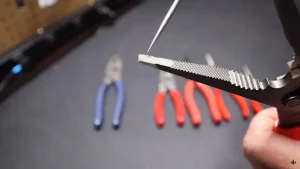
Jewelry Making and Crafts by Needle Nose Pliers
Here are some specific applications of needle nose pliers in these domains:
Wire Wrapping: Needle nose pliers are essential for wire wrapping techniques in jewelry making. They enable you to grip and manipulate wires to create intricate designs, secure beads or stones, and form decorative wire elements.
Looping and Bending: Needle nose pliers excel at forming loops, bends, and curves in wire. They allow you to create jump rings, eye pins, ear wires, and other components used in jewelry making and crafts.
Precision Handling: The fine, pointed tips of needle nose pliers provide precise control when handling small beads, findings, or delicate components. They help you position, hold, and attach these elements accurately.
Wire Cutting and Stripping: Needle nose pliers often come with integrated wire cutters, enabling you to trim wires to the desired lengths. They can also strip insulation from wire ends, making them versatile tools for wirework.
Opening and Closing Jump Rings: Needle nose pliers are commonly used to open and close jump rings, which are essential for connecting components in jewelry making. The pliers’ jaws provide a secure grip on the ring while allowing you to manipulate it smoothly.
Embellishment and Detailing: Needle nose plier helps add intricate embellishments and details to jewelry pieces or other crafts. They enable you to twist, wrap, and shape wire to create unique and personalized designs.
Repair and Adjustments: The needle nose plier is handy for making repairs or adjustments to jewelry or craft projects. They allow you to fix broken or misshapen elements, reposition components, or make small modifications to existing pieces.
Handling Small Beads and Findings: The needle nose plier is ideal for handling small beads and findings in jewelry making. Their fine tips provide a secure grip for threading beads, opening and closing jump rings, attaching clasps, and adding embellishments. With needle nose pliers, you can handle delicate components with precision, ensuring smooth and accurate placement in your designs.
Opening and closing jump rings: Needle nose pliers are excellent tools for opening and closing jump rings in jewelry making. The long, slender jaws and pointed tips of needle nose pliers provide a secure grip on the jump ring, allowing you to manipulate and control it with precision. With gentle pressure and using a twisting motion, you can easily open and close jump rings, making them versatile tools for connecting various components and findings in your jewelry projects.
Mechanical and Automotive Repairs
While needle nose pliers are not typically the primary tools used for mechanical and automotive repairs, they can still be handy in certain situations. Here are a few ways needle nose pliers can be useful:
Gripping and Holding: Needle nose pliers can be used to grip and hold small components or objects in place during mechanical repairs. Their long, slender jaws allow for better access to tight spaces.
Wire Handling: Needle nose pliers can assist in handling and manipulating wires during electrical repairs in automotive systems. They can be used for tasks like stripping insulation, crimping connectors, or reaching into confined spaces to secure or adjust wiring.
Removing or Installing Small Parts: Needle nose pliers can help remove or install small parts, such as clips, pins, or retaining rings, which are commonly found in mechanical and automotive systems.
Retrieving Objects: In instances where small objects or fasteners fall into tight spots or are difficult to reach, needle nose pliers can be used to retrieve them.
Removing and Installing Retaining Clips
Here’s how they can be used:
Removing Retaining Clips or Pins: The needle nose plier can grip the edges or ends of retaining clips or pins, allowing you to compress or manipulate them for removal. By squeezing the pliers’ jaws, you can release the tension and disengage the clip or pin from its position.
Installing Retaining Clips or Pins: When installing retaining clips or pins, needle nose pliers can assist in positioning and securing them in place. By gripping the clip or pin with the pliers, you can guide it into the desired position and release it once it is properly seated.
Adjusting Retaining Clips: A needle nose plier can also be used to adjust the tension or position of retaining clips. By carefully squeezing or prying with the pliers, you can increase or decrease the tightness of the clip to ensure a proper fit or alignment.
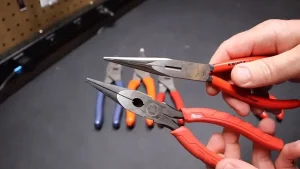
Working with Small Screws and Fasteners
Gripping and Holding: Needle nose pliers can be used to grip and hold small screws or fasteners in place when access is limited, or when a screwdriver or wrench is not readily available.
Starting Screws: In some cases, needle nose pliers can help start a small screw by gripping its head and turning it until it catches in the material. This can be useful when a screwdriver is not immediately accessible.
Removing Stripped Screws: If a small screw becomes stripped or difficult to turn, needle nose pliers can be used to grip the head of the screw and apply rotational force to remove it.
Emergency Situations: When faced with a situation where a small screw needs to be tightened or loosened quickly, but the appropriate screwdriver is not available, needle nose pliers can provide a temporary solution.
Types of Needle Nose Pliers
There are several kinds.| Type | Description |
|---|---|
| Standard | These are most common. They are simple. |
| Bent Nose | The tips are curved. They reach tricky places. |
| Long Reach | They have extra-long noses. They go very deep. |
| Flush Cutting | They cut wires cleanly. No spikes are left. |
Choosing the Right Pair
You must pick the best one. Here are tips to help you choose:- Think about your task. What will you do?
- Get ones that feel good. Will they fit your hand?
- Quality is important. They should last long.
- Look for good handles. They should not slip.
Tips for Using Needle Nose Pliers Effectively
Here are some tips for using effectively:
Choose the Right Size: Needle nose pliers come in various sizes. Select a pair that suits the task at hand. Smaller pliers provide more precision for delicate work, while larger ones offer more gripping strength for heavier-duty tasks.
Grip Close to the Tip: To maximize control and precision, grip the object or wire as close to the tip of the pliers as possible. This allows for better manipulation and reduces the risk of slippage.
Apply Steady Pressure: Use a consistent and steady pressure when using needle nose pliers. Avoid applying excessive force, as it can lead to damage or deformation of the material you’re working with.
Use the Right Jaw Section: Needle nose pliers often have different sections along their jaws, such as flat, serrated, or rounded. Select the appropriate section for your specific task. For example, the serrated section can provide a better grip on smooth surfaces, while the rounded section is useful for creating loops or curves.
Mind the Material: Consider the material you’re working with. Needle nose pliers can cause scratches or dents on delicate surfaces. To protect the material, you can wrap the pliers’ jaws with a soft cloth or use specialized jewelry pliers with nylon-coated jaws.
Support the Workpiece: When working on larger or heavier objects, use your free hand or additional tools to support and stabilize the workpiece. This helps prevent undue stress on the pliers and allows for better control.
Practice and Familiarize Yourself: Like any tool, using needle nose pliers effectively requires practice. Spend time familiarizing yourself with the pliers’ feel and capabilities by experimenting with different tasks and materials.
Remember to prioritize safety when using any tools. Wear appropriate protective gear and exercise caution to avoid injury.
Safety Precautions and Handling Tips
Proper maintenance and care of needle nose pliers can help extend their lifespan and ensure their effectiveness. Here are some tips to keep your pliers tools in good condition:
Keep Them Clean: After each use, wipe down the pliers with a clean cloth to remove any dirt, debris, or residue. This helps prevent buildup and corrosion.
Oil the Joints: Apply a small amount of oil, such as sewing machine oil or a lightweight lubricant, to the joint area of the pliers. This helps keep the joint smooth and prevents rust or stiffness.
Store Properly: When not in use, store your needle nose pliers in a dry location to protect them from moisture and humidity. Consider using a tool rack or a dedicated tool drawer to keep them organized and prevent damage.
Avoid Excessive Force: Needle nose pliers are designed for precise work and may not withstand excessive force. Avoid using them for tasks that require heavy-duty strength beyond their intended capabilities.
Avoid Overextension: While needle nose pliers have a long reach, try to avoid opening them beyond their natural limit. Overextending the jaws can cause misalignment or damage to the pliers.
Protect the Tips: The fine tips of needle nose pliers are crucial for delicate tasks. Take care to avoid dropping or banging them, as this can deform or blunt the tips. Consider using a tool roll or protective case for transportation and storage.
Inspect for Damage: Regularly inspect your needle nose pliers for any signs of damage, such as bent or misaligned jaws. If you notice any issues, discontinue use and repair or replace the pliers as necessary.
You can keep your needle nose pliers in good working condition, ensuring their effectiveness and longevity.
Conclusion: A Must-Have Tool
The needle nose plier is very helpful. They grab small items well. They reach where hands can’t. Every toolkit should have them. They make your work easier.
Frequently Asked Questions For Needle Nose Pliers: Essential Tool For Precision Work
What Are Needle Nose Pliers Used For?
Needle nose pliers are versatile tools ideal for gripping, bending, and cutting fine wires in tight spaces due to their elongated, tapered jaws.
Can Needle Nose Pliers Cut Wire?
Yes, needle nose pliers can cut wire, particularly suited for precision tasks requiring delicate trimming of thin gauge wires.
Do Needle Nose Pliers Come In Sizes?
Yes, they’re available in various sizes to accommodate different tasks, ranging from intricate jewelry making to electrical repairs.
Which Features To Look For In Needle Nose Pliers?
Key features include a comfortable grip, precise jaw alignment, and a durable cutting edge for efficient performance.

